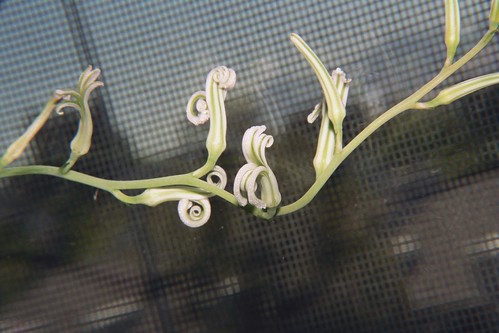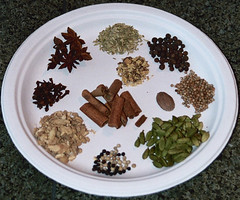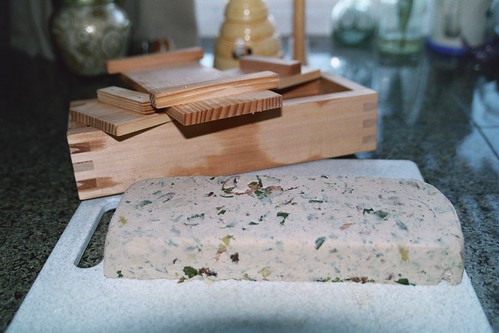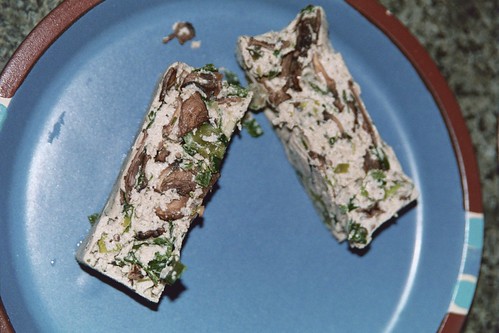Now, we hadn’t forgotten that we were going to try and really do something with tofu, but sourdough starter… sort of takes over the world when it gets going. But eventually we knew we had to make tofu again — after all, freshly ground chai-spiced soy milk and hot cocoa tastes best with fresh soy milk. We finally had a good excuse — well, another good excuse, anyway, to pull out the beans.
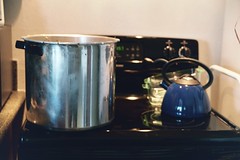
The other night, we put a pound of dried soybeans in to soak, and started the usual drill: beans double in size and are drained, then ground in the blender and the resulting white goopy paste is boiled in a monster pot for twenty-five minutes after its first foam appears.
(NOTE: If there’s ever any doubt about whether or not the foam has appeared…? Then it hasn’t foamed. It’s like watching what happens when you put dish detergent into the washing machine. BIG bubbles, fast.)
Normally, after this step, the okara is cooked and rises to the top. Usually, we simply take the milk off the heat, then pour it through a muslin strainer. This time, multi-tasking led us to leaving it on the stove. It grew a skin. A light went on in our brains. “Hey! We made yuba!” Yuba is a thin bean curd… skin that is sometimes fried in Chinese restaurants and served with various spices as “Buddha’s (Buddha being a vegetarian Deity.) “Mock Duck,” (recipe via The Vegan Feast Kitchen). Yuba is very high in protein — higher than either tofu or milk. Seasoned and fried or eaten with condiments, it’s quite tasty – but pretty high maintenance to make if you’re making soy milk from scratch…
So, we set aside our Yuba Quest for another day, and continued on our path. We loaded the okara on drying screens and then pondered the hot soy milk. Our original quest was to experiment our way toward something like feta. We’ve seen recipes for something like ricotta, with cashews and almond, but we wanted to create something …else.
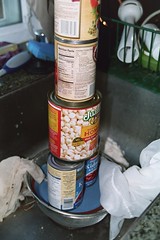
“What if we flavored it?” one of us asked. (Who knows which one of us. Genius generally strikes anonymously.) “Well, we’ve got these dried leeks and mushrooms…” the other of us mused. The consensus of “why not?” meant that before adding coagulant, we added a quarter cup of whole, dried sage, two cups of dried leek pieces and about two cups of dried champignon mushrooms. Then we added the coagulant, poured it through the strainer (sheer polyester mesh, since with the newly organized kitchen, who knows what happened to the rest of the cheesecloth and muslin) into the molds (one a Japanese sushi mold, not really meant for tofu, but it works, and it’s beautifully made, so it gets used, and the other “mold” is a stainless steel strainer. With a dish and cans on top of it for weight Again: it works.), and we waited.
Our first fear was that the coagulant — magnesium sulfate, and truly awful, if you’ve ever had the misfortune to taste it — would alter the taste of the vegetables put into the soy milk — but since the horribly sourish-bitterness is undetectable in homemade tofu, we took our chances. Our second fear was that we should maybe have added something else — the leeks were making it look a little greenish. Maybe we should have added saffron or turmeric. Perhaps the consistency would be strange.
Well, as you can see, we worried needlessly. You can SEE what it LOOKS like. My goodness, I wish you could smell and taste it. Think of savory onions and mushrooms…
Many people are ambivalent about tofu, thinking “meh” because it is basically white, somewhat gelatinous (if it’s silken, really gelatinous), and entirely tasteless (unless it’s made from a stronger milk source and then it has a heavier soy flavor that still basically tastes like… not much). Many view the vegans and vegetarians who enjoy it as humorless (and tasteless) ascetics, but I’m here to tell you that I don’t bother eating things that don’t taste good. This. Tofu. Tastes. Good.
If we were coming up with a name for this, I would say it is ganmodoki-style — almost. Ganmodoki is a Japanese method of mixing crumbled tofu, vegetables and mountain yam (yama-imo) and forming it into patties or balls and deep frying it. Without the yams (darn) or the frying, this is close. We could simply call this ‘flavored tofu,’ or ‘vegetable tofu,’ but we’ve been calling it …quiche. I know. That name’s taken.
We ate this “raw,” and warm, straight from the press with just a little soy sauce, and it was really nice. We baked it with a smidge of olive oil, and about a teaspoon each of garlic powder, salt, curry powder, freshly ground black pepper, and smoked torula yeast, and wow — it took on subtle flavors that were unexpected. Paired with a green salad, it becomes a most satisfying egg-and-onion pie. Lightly stir fried and paired with grilled tomatoes, it’s amazingly like a breakfast bake of eggs and mushrooms. It’s an unbelievably versatile food, and now we’re wondering: why stop at tofeta? The possibilities are endless…






